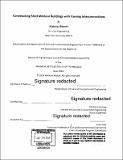| dc.contributor.advisor | Gordana Herning. | en_US |
| dc.contributor.author | Rostek, Mateusz | en_US |
| dc.contributor.other | Massachusetts Institute of Technology. Department of Civil and Environmental Engineering. | en_US |
| dc.date.accessioned | 2018-11-28T15:43:06Z | |
| dc.date.available | 2018-11-28T15:43:06Z | |
| dc.date.copyright | 2018 | en_US |
| dc.date.issued | 2018 | en_US |
| dc.identifier.uri | http://hdl.handle.net/1721.1/119321 | |
| dc.description | Thesis: M. Eng., Massachusetts Institute of Technology, Department of Civil and Environmental Engineering, 2018. | en_US |
| dc.description | Cataloged from PDF version of thesis. | en_US |
| dc.description | Includes bibliographical references (pages 86-88). | en_US |
| dc.description.abstract | Modular construction uses prefabricated building components called modules, which are fabricated in a factory, transported to a site, and then assembled together to create a building. A "module" is one of the building blocks used to construct a modular building and may be comprised of a load bearing structure, MEP components, interior finishes, and exterior cladding. This alternate way of building using prefabricated units leads to advantages such as: faster construction, cost savings, and sustainability benefits. Historically, modular construction has predominantly been used in the development of low rise, temporary, or portable buildings. However, recently this prefabricated building technology has spread into multi-story applications and a wider range of building types such as hospitals, residential complexes, and schools. As more high-rise buildings are being built using modular construction, new structural challenges must be addressed. Lateral and gravity loads increase with height and the design of building connections and their lateral force resisting systems becomes ever more critical. Although several case studies describing modular buildings are publicly available, there is a lack of detailed scientific data explaining their structural performance. This thesis attempts to shorten the knowledge gap by investigating the effect interconnections have on the behavior of a modular building. In this study modular interconnections are defined as the connections within modular buildings which link discrete modules together allowing them to act as a single structure. Modular interconnections are a keen area of interest as their design affects the global behavior of a modular building. To understand the effect different interconnections have on the stability of a modular building, a study is conducted where several building prototypes with various interconnections are modelled and analyzed. | en_US |
| dc.description.statementofresponsibility | by Mateusz Rostek. | en_US |
| dc.format.extent | 88 pages | en_US |
| dc.language.iso | eng | en_US |
| dc.publisher | Massachusetts Institute of Technology | en_US |
| dc.rights | MIT theses are protected by copyright. They may be viewed, downloaded, or printed from this source but further reproduction or distribution in any format is prohibited without written permission. | en_US |
| dc.rights.uri | http://dspace.mit.edu/handle/1721.1/7582 | en_US |
| dc.subject | Civil and Environmental Engineering. | en_US |
| dc.title | Constructing steel modular buildings with varying interconnections | en_US |
| dc.type | Thesis | en_US |
| dc.description.degree | M. Eng. | en_US |
| dc.contributor.department | Massachusetts Institute of Technology. Department of Civil and Environmental Engineering | |
| dc.identifier.oclc | 1062522382 | en_US |
